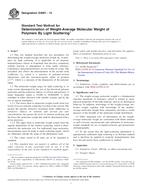Potřebujeme váš souhlas k využití jednotlivých dat, aby se vám mimo jiné mohly ukazovat informace týkající se vašich zájmů. Souhlas udělíte kliknutím na tlačítko „OK“.
ASTM D4001-13
Standard Test Method for Determination of Weight-Average Molecular Weight of Polymers By Light Scattering
Automaticky přeložený název:
Standardní zkušební metoda pro stanovení hmotnosti, průměrná molekulová hmotnost polymerů pomocí rozptylu světla
NORMA vydána dne 1.11.2013
Informace o normě:
Označení normy: ASTM D4001-13
Poznámka: NEPLATNÁ
Datum vydání normy: 1.11.2013
Kód zboží: NS-25683
Počet stran: 12
Přibližná hmotnost: 36 g (0.08 liber)
Země: Americká technická norma
Kategorie: Technické normy ASTM
Kategorie - podobné normy:
Anotace textu normy ASTM D4001-13 :
Keywords:
light scattering, polymers, weight-average molecular weight, ICS Number Code 83.080.01 (Plastics in general)
Doplňující informace
| Significance and Use | ||
|
4.1 The weight-average molecular weight is a fundamental structure parameter of polymers, which is related to many physical properties of the bulk material, such as its rheological behavior. In addition, knowledge of the weight-average molecular weight, together with knowledge of the number-average molecular weight from osmometry, provides a useful measure of the breadth of the molecular-weight distribution. 4.2 Other important uses of information on the weight-average molecular weight are correlation with dilute-solution or melt-viscosity measurements and calibration of molecular-weight standards for use in liquid-exclusion (gel-permeation) chromatography. 4.3 To the extent that the light-scattering photometer is appropriately calibrated, light scattering is an absolute method and is therefore be applied to nonionic homopolymers that have not previously been synthesized or studied. |
||
| 1. Scope | ||
|
1.1 This test method describes the test procedures for determining the weight-average molecular weight Mw of polymers by light scattering. It is applicable to all nonionic homopolymers (linear or branched) that dissolve completely without reaction or degradation to form stable solutions. Copolymers and polyelectrolytes are not within its scope. The procedure also allows the determination of the second virial coefficient, A2, which is a measure of polymer-solvent interactions, and the root-mean-square radius of gyration (s2)1/2, which is a measure of the dimensions of the polymer chain. 1.2 The molecular-weight range for light scattering is, to some extent, determined by the size of the dissolved polymer molecules and the refractive indices of solvent and polymer. A range frequently stated is 10,000 to 10,000,000, is often extended in either direction with suitable systems and by the use of special techniques. 1.2.1 The lower limit to molecular weight results from low levels of excess solution scattering over that of the solvent. The greater the specific refractive increment dn/dc (difference in refractive indices of solution and solvent per unit concentration), the greater the level of solution scattering and the lower the molecular weight that shall be determined with a given precision. 1.2.2 The upper limit to molecular weight results from the angular dependence of the solution scattering, which is determined by the molecular size. For sufficiently large molecules, measurements must be made at small scattering angles, which are ultimately outside the range of the photometer used. 1.3 The values stated in SI units are to be regarded as standard. 1.4 This standard does not purport to address all of the safety concerns, if any, associated with its use. It is the responsibility of the user of this standard to establish appropriate safety and health practices and determine the applicability of regulatory limitations prior to use.
|
IEEE/ASTM?SI-10
|
American National Standard for Use of the International System of Units (SI): The Modern Metric System |
Doporučujeme:
Aktualizace technických norem
Chcete mít jistotu, že používáte pouze platné technické normy?
Nabízíme Vám řešení, které Vám zajistí měsíční přehled o aktuálnosti norem, které používáte.
Chcete vědět více informací? Podívejte se na tuto stránku.




 Cookies
Cookies
